Day 8
May 11, 2003
(Sunday)
Athens
6:30 am
We're up and in Athens, Greece, where we're going to see some REALLY old stuff
(not like that practically brand new Renaissance stuff we saw in Italy). People
have been planting olive oil and drinking ouzo for some 5,000 years (10,000 years
Canadian).
We actually dock in Piraeus which is sort of a suburb of Athens, about 10 miles
from downtown.

Panorama of Piraeus at dawn
We remember Piraeus well, because it was one of the two ports we made on our last
trip here. We especially remember it, because we wandered off from the tour and
found ourselves in downtown Athens with only a few hours to get back to the ship
(yikes!). We eventually found our way to a train station and figured out how to
get back to Piraeus by spelling out the name of the town one letter at a time.
The problem is that we learned most of our Greek letters in math and science,
so we had to look for "3.14156, inductance, radiation, ohms, summation, and inside
angle." ("No, wait, that place name starts with the matrix transformation symbol,
this can't be where we get off!")
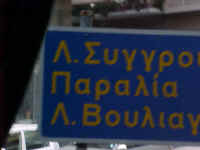
"Piraeus" (second from the top)
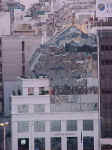
Building in Athens
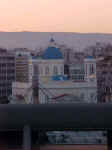
Church in Athens
7:30 am
We are on the tour bus, with our guide Eva (short for "Evangelica," a Greek girl's
name meaning "Good News"). A guy gets on the bus selling tour books ("$5 US! You
no want? Okay, no problem. I hope you don't feel sorry later.") We admire this
entrepreneurial attitude and buy one (with 10 free postcards!).
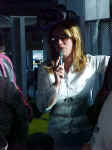
Eva, our guide for the day in Athens
It's sunny but still a little hazy. The average temperature here the last few
days has been in the low 30s (Celsius, which is like 90 degrees real temperature).
There are only 500 days until the summer Olympics, which will be held in Athens.
In August. When it gets really hot. Like 120 degrees. We expect that a popular
event to watch on TV will be called "Collapsing Athletes."
Greece is the crossroads for three continents, and has been invaded by just about
every country, except Luxembourg. Most recently, the evil Turks ruled for some
200 years, until the brave Greeks rebelled and threw them out. (Travel Tip: Don't
order turkey here, or you may find some fingers and toes on your plate.)
In the 1920s in fact, the Greeks made all the Turks leave and go back to Turkey,
and the Turks made all the Greeks go back to Greece. This kinda swelled the population
of Athens by a million or so people. Today, there's five million Greeks who live
in Athens, but most of them are out of town today, because it's the weekend.
For many many years, Greece was the shipbuilding capital of the world. These days,
though, tourism is the big industry, and 17% of the people are directly employed
in the tourism trade.
Eva also told us about building the new subway system, which is getting close
to being finished. The problem is that after 5,000 years of people living here,
you can't dig a hole for a tomato plant without finding a rare
archaeological artifact.
While building the subway, they had to keep stopping as they found 40,000 important
artifacts ("Not counting the unimportant and the broken ones").
8:00 am
We are headed for the Corinth canal. This joins the Ionian and Aegean seas. If
you don't use the canal, you have to go way and the hell around through the fun-to-say
Pelopponese Peninsula, which takes a couple of days (if you're lucky and don't
crash into anything).
They tried building the canal back in the sixth century BC, but soon gave up because
they hadn't invented backhoes yet. So, instead, they built a road and rolled the
boats across the isthmus to the other sea (it's not clear if the wheels were built
into the boat, or if they put the boats on a wheeled platform). In any case, it
took all night to do it, and they charged a toll for this service.
On the way to the canal, Eva regales us with tales from Greek mythology. Every
place has a name, and every name has a long, involved story, usually involving
sex, betrayal and gods disguised as humans. Seems like back then, you'd always
be nervous, never knowing if that was a beggar or the Goddess Artemis out for
a lark.
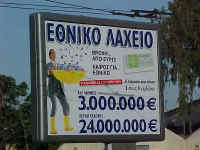
What's this sign say?
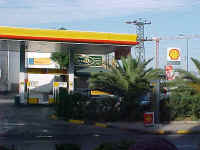
Some things transcend language
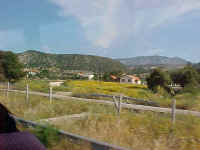
Greek countryside
We also hear about an important naval battle with the Phoenicians (as we pass
by the narrow place where it occurred). Seems that the king at the time went to
the Oracle at Delphi (well known for giving cryptic answers to questions--which
didn't seem to affect business very much) and was told to protect the city with
a "wooden wall."
Some people wanted to build an actual wooden wall around the city, but a smart
guy figured out that the Oracle meant a wall of wooden boats to protect the city.
The problem was that the Phoenicians had bigger boats and would kick the snot
out of the Greeks in the open sea. So the Greeks lured them into a narrow strait
where they couldn't maneuver, and mopped up the sea floor with them.
This is why the ancient Greeks didn't invent TV. They were having way too much
fun telling and retelling these kinds of stories.
9:18 am
We stop at a bridge that passes over the Corinth canal. We can see why the 6th
Century Greeks gave up on digging the canal with shovels. It's a lo-o-o-o-n-g
way to the bottom.
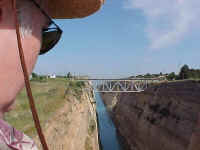
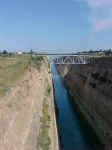
Robert gazes down on the Corinth canal
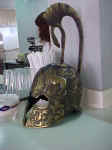
This helmet was on the counter in the coffee shop
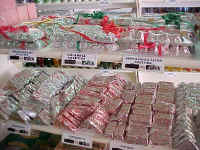
We have no idea what these were, but we think you can eat them. We didn't.
We wander through the Greek shop next to the bridge, where everybody is talking
at once (loudly, and in Greek). Robert gets a coffee.
Travel Tip
First you buy a ticket for what you want, then you go to where they serve it
and give them the ticket and they give you what you ordered. They use this
same procedure in Italy, too.
9:33 am
We board a two-masted caique--schooner--called the "Santa Maria" ("Where's the
Pinta and the Nina?" asks Robert, but too many people slept through history class
and didn't get the joke). Although it's rigged for sail, the captain motors everywhere,
and we think the rigging is just for show.
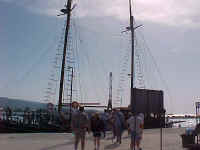
The Santa Maria (the one we rode on, not the one Chris rode on)
The Corinth canal is 6.3 kilometers (4 miles) long (another reason not to dig
it with shovels). It takes about half an hour to motor from one end to the other.
The other cool thing is that the canal doesn't have drawbridges, they have sinking
bridges! The bridges sink down ("until they become one with the bottom" says Eva)
so the boats can pass.
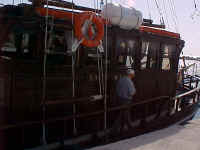
Our boat, but not our captain (he was busy drinking Ouzo someplace else)
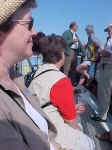
Laura enjoys the sun
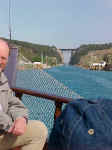
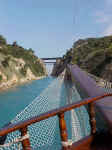
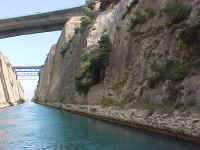
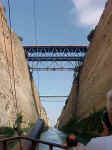
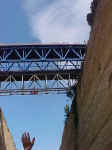
Passing underneath the bridge (from which we looked down)
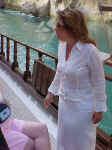
Our guide, Eva, explains still more Greek history
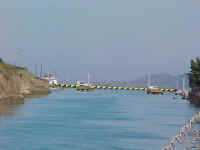
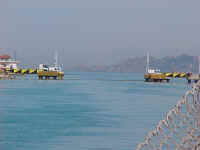
The amazing sinking bridge: now you see it, now you don't!
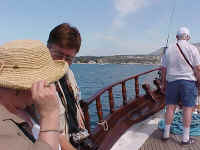
Laura talks to a German tourist, eager to practice his English (and
chat up a cute woman!)
Robert says Seattle needs one of those sinking bridges, but then remembers that we already have
one in the old I-90 bridge.
11:25 am
We stop for lunch at a hotel in Kineta, which serves a buffet-style lunch. The
nice thing is that we get a choice of what to eat; the drawback is that we have
no real idea what the heck we're eating.
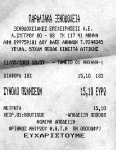
We bought something, but we have no idea what
Robert gets some meat in gravy (lamb?), and a couple of things that seem to be
spinach and pastry mixtures. For dessert, there's unambiguous (and yummy) puff pastries.
Robert wanders off to the bar and finally manages to get a Greek coffee (which
is similar to Turkish coffee, except that Turkish coffee is evil and Greek coffee
is good). This is a very strong coffee made from equal parts finely ground coffee,
water, and sugar.
12:30 pm
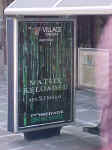
We wonder what it would be like to hear Neo say "Whoa!" in Greek
We're on our way to drive through Athens and see a bunch of ruins. Along the way,
Eva tells us the difference between the Acropolis and the Parthenon:
Acropolis = whole top of hill
Parthenon = temple on hill
Also, the main export of Greece is olive oil (who knew olives needed so much oiling?)
and oranges (mostly to the EC, which is what us world travelers call the European
Community).
1:30 pm
We drive through downtown Athens. They are doing a ton of renovations for the
Olympics--fixing stuff, rebuilding stuff, making new roads. Eva says that if we
come back for the Olympics (in August, remember, one of the REALLY hot months),
it will look completely different. We decide to wait for the video.
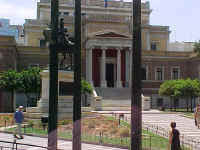
Important government building in Athens (we think the guy on the horse is
some kind of founding guy)
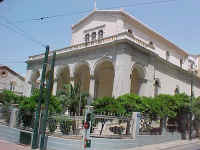
Another important government building in Athens
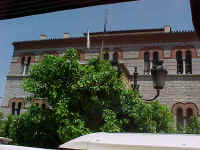
There's no end to the government buildings
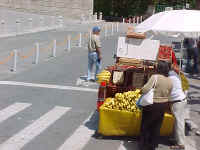
Yes, we have lots of bananas!
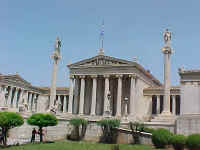
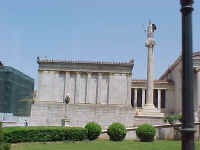
A library, or a government building (or maybe a university)
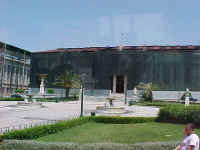
A plaza, flanked by government buildings
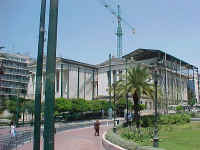
Government buildings undergoing their regular 5,000 year maintenance
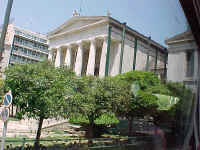
Notice how everything looks like a Greek temple around here?
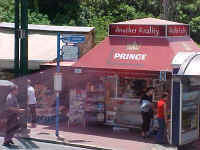
When they want to sell you something, they suddenly know lots of English!
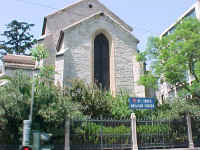
Hey! They have Episcopalians here! (St. Paul's Anglican Church)
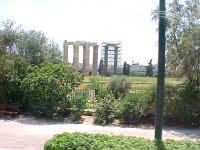
Temple of Zeus
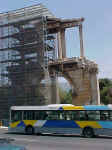
Hadrian's Arch (they're fixing it up for the guests coming next year)
One of the famous places is the ruins of the Temple of Zeus. Seems it took about
800 years to finish (why is it that churches always take so long to build?). In
fact, when the Roman Emperor Hadrian cracked the whip and made the Greeks finish
it, they were so happy they build him his own entrance called Hadrian's Arch.
1:55 pm
We pause outside Olympic Stadium which holds 65,000 people (it's being renovated,
of course).
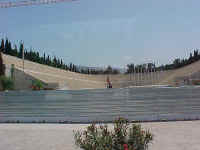
Olympic Stadium waits for the Olympics
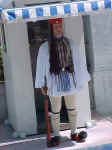
The guards here wear dresses and funny shoes
1:50 pm
We hear the story of the 14-year-old boy who ran from where the Greeks were about
to be overrun at the battle of Marathon to ask for help from the Spartans. But
it was Sunday, so the Spartans said they couldn't help. So he ran back to the
battle field and fought for a while. After the Greeks won (they weren't supposed
to), he ran back to Athens, announced, "We won!" and died.
The modern Marathon isn't quite as rigorous (buncha soft modern people) and they
only recreate the last part of his run (26 miles from Marathon to Athens). When
they do the Olympics next year, they will retrace the original route for the Marathon
part of the Olympics. Given the heat, the recreation may be more accurate than
expected....
2:18 pm
We are at the Acropolis. We are warned about posing with the statues for pictures
(you can't stand next to a statue and have your picture taken). Also, no Coke
or Sprite cans (no brand names; apparently the fear is some Coke commercial will
appear with the tag line: "Coke--soft drink of the Gods!").
We stop at the Odeon, or small theater. This held only 5,000 people, and was used
mostly for music. There's a larger theater that held some 20,000 people and was
used for theater. (Remember, theater was invented here--well, on that hill over
there, actually.)
Originally, they did plays only every four years in conjunction with the Olympics.
They would do shows all day long, and the audience would bring their lunches with
them. If the show was bad, they would throw what was nearby--hence the great theatrical
tradition of tossing tomatoes at the bad acts.
The judges would decide which plays were the best and give prizes of money. Of
course, most of the money went to the producers, and to pay for the sets, thus
beginning the theatrical tradition of poor actors.
In between Olympics, the shows would go on tour throughout Greece ("As seen in
Athens!"). This all started in the fifth century before Jesus.
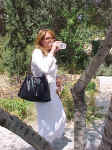
Eva our guide, getting hydrated
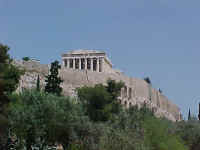
Parthenon on the Acropolis

Panorama of Athens, overlooking the Odeon
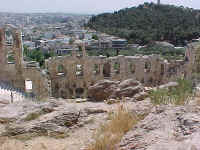
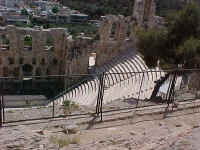
Odeon Theater where drama was invented
3:00 pm
We're (gasp!) finally (gasp!) at the top. It's about 8,000 degrees outside and
relentlessly sunny and hot.

Athens, seen from the top of the Acropolis
But it's pretty damn impressive. The Parthenon is big, although they don't let
you wander around inside of it. In fact, some of the outside art (like the friezes
at the top) is replicas. They took the originals inside to protect them from the
elements (you can see them in the museum nearby).
There're roped-off areas where you're not supposed to go, and curators blow shrill
whistles at you when you cross the line. One guy didn't pay attention and the
curator came over and chewed him out in Greek. Being chewed out in Greek is pretty
effective because whatever they are saying it sounds like "I will pull your lungs
out through your nose and wrap them around your head!"
Even Robert decides not to challenge these particular boundaries.
The Parthenon isn't just a fancy-schmancy temple. It's also the very first pork
barrel project. A short distance away, they invented democracy, and the people
voted to elect their own leaders.
About fifteen minutes after the leaders were elected, they started worrying about
being re-elected. They decided that if they built a big temple, it would provide
jobs to a lot of the workers (who would vote for them, of course) and be something
they could point at when running for re-election.
See? There really isn't anything new under the sun--whatever it is, the Greeks
were doing it a long time ago.

Panorama of the Acropolis, while our guide, Eva, explains about the
Parthenon
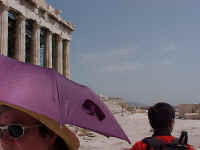
Laura and the Parthenon
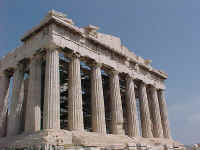
The Parthenon by itself
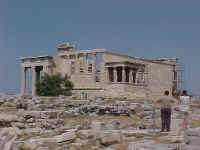
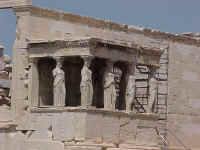
The Erechtheion on the south side are the Caryatids, who not only hold up the roof,
but they are also girls
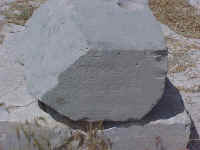
Greek writing on marble
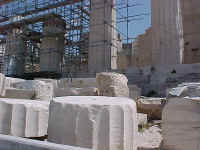
They're jazzing it up for the Olympics
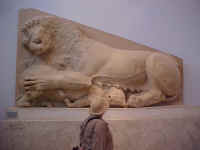
A lioness savaging a bull from the right wing
of a large archaic limestone pediment
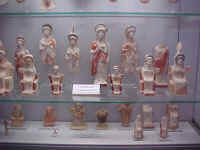
Terracotta figures and protomes
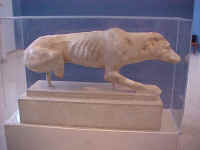
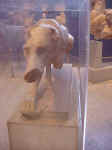
How much is that doggy in the window?
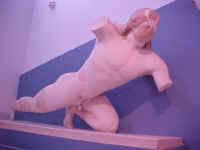
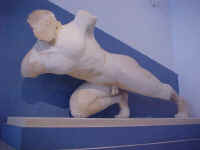
The Gigantomachia Pediment
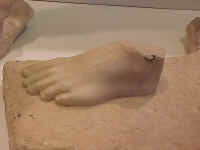
A footloose foot
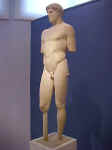
The "Kritios boy."
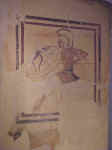
Terracotta votive plaque
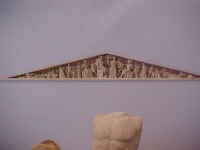
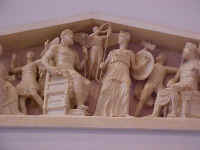
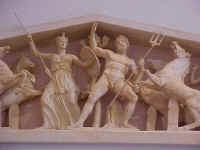
Some cool teeny sculptures
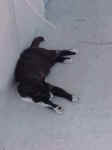
Even the cats are overwhelmed by the heat
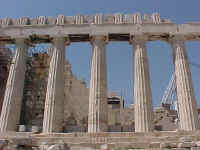
Pillars of the Parthenon
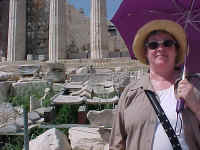
Laura in front of the pillars of the Parthenon (in the court of King
Karaktikus)

From the Parthenon you can see just about all of Athens
On the way out, we see some "new" (freshly mined) marble they are bringing in
for some restoration work. The marble is shockingly white, especially in the blazing
sun.
We imagine the whole building looking like this, and realize it would be a great
shining temple that would be hard to look at because it was so bright. Considering
you could see it from everyplace in Athens it would have been pretty reassuring
(and an effective campaign sign!).
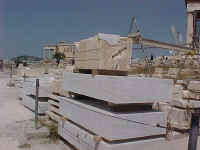
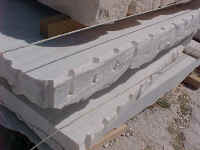
New marble
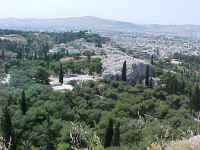
This is the birthplace of theater--Melius Gibsonius opened here!
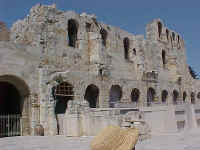
The front of the Odeon (the box office should be around here someplace!)
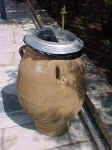
Even the ashtrays are priceless antiques (or look like them, anyway)
4:06 pm
Oh look! The guide has taken us to a store where we can spend money! Laura gets
some pretty earrings. Robert tries to persuade her to get some coasters featuring
scenes from Greek pottery ("These'd be great for company!") but Laura gets a look
at the scenes and takes a big pass.
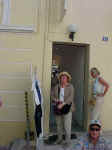
Laura in front of the quaint shop
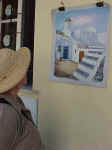
Laura gazing at a quaint drawing in the quaint shop
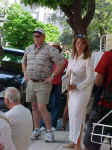
Our guide Eva isn't quaint
We get back on the bus (yay air conditioning!) and make it back to the boat before
it leaves. Our little feetsies are plenty sore (and covered with the dust of centuries!).
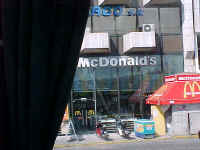
Yup--even the birthplace of Western Civilization can give you fries with
that
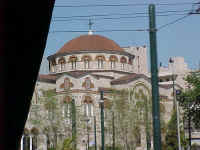
Some church or another, we lost track of which one
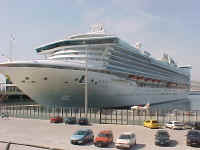
Our boat looms
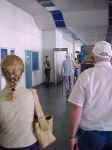
The exhaustive security we had to pass through
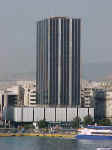
They can only use the lower area of this building, because the rest of the
building is slanted and all the chairs roll to one side
Around 6:00 pm
The ship pulls out of its parking space and heads for Turkey.
On our way to Kusadasi, Turkey
Robert & Laura
|
